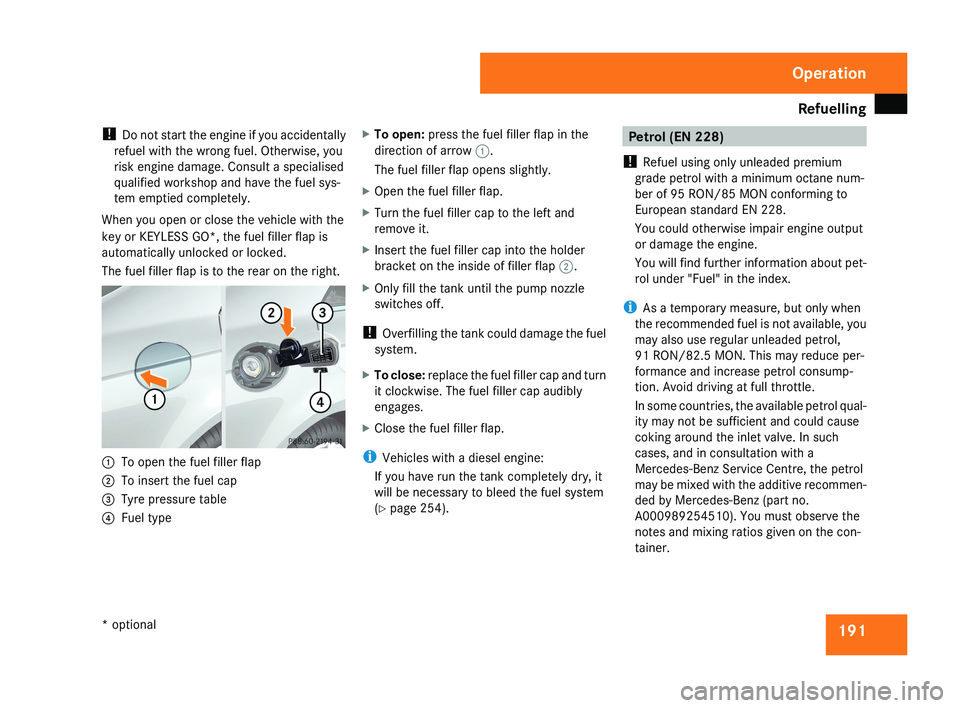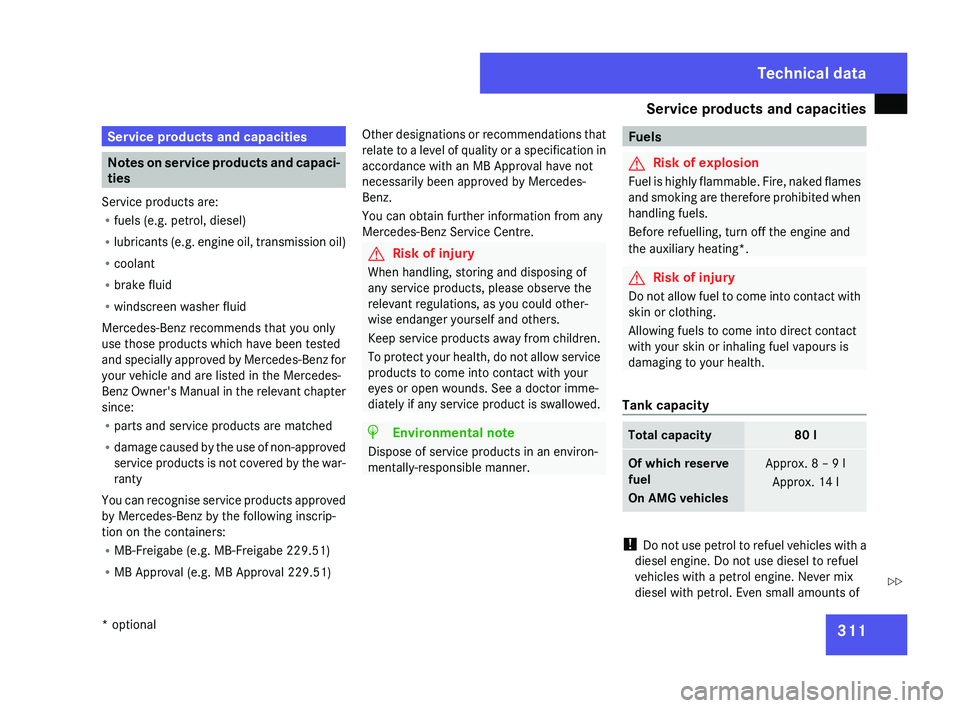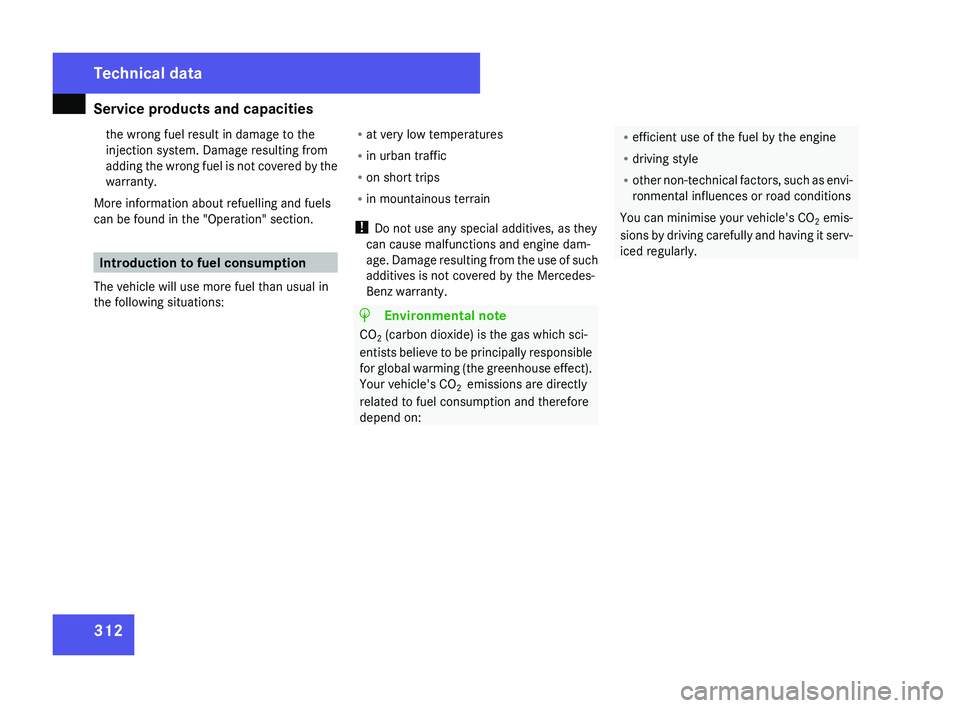Page 194 of 329

Refuelling
191
!
Do not start the engine if you accidentally
refuel with the wrong fuel. Otherwise, you
risk engine damage. Consult a specialised
qualified workshop and have the fuel sys-
tem emptied completely.
When you open or close the vehicle with the
key or KEYLESS GO*, the fuel filler flap is
automatically unlocked or locked.
The fuel filler flap is to the rear on the right.1 To open the fuel filler flap
2 To insert the fuel cap
3 Tyre pressure table
4 Fuel type X
To open: press the fuel filler flap in the
direction of arrow 1.
The fuel filler flap opens slightly.
X Open the fuel filler flap.
X Turn the fuel filler cap to the left and
remove it.
X Insert the fuel filler cap into the holder
bracket on the inside of filler flap 2.
X Only fill the tank until the pump nozzle
switches off.
! Overfilling the tank could damage the fuel
system.
X To close: replace the fuel filler cap and turn
it clockwise. The fuel filler cap audibly
engages.
X Close the fuel filler flap.
i Vehicles with a diesel engine:
If you have run the tank completely dry, it
will be necessary to bleed the fuel system
(Y page 254).
Petrol (EN 228)
! Refuel using only unleaded premium
grade petrol with a minimum octane num-
ber of 95 RON/85 MON conforming to
European standard EN 228.
You could otherwise impair engine output
or damage the engine.
You will find further information about pet-
rol under "Fuel" in the index.
i As a temporary measure, but only when
the recommended fuel is not available, you
may also use regular unleaded petrol,
91 RON/82.5 MON. This may reduce per-
formance and increase petrol consump-
tion. Avoid driving at full throttle.
In some countries, the available petrol qual-
ity may not be sufficient and could cause
coking around the inlet valve. In such
cases, and in consultation with a
Mercedes-Benz Service Centre, the petrol
may be mixed with the additive recommen-
ded by Mercedes-Benz (part no.
A000989254510). You must observe the
notes and mixing ratios given on the con-
tainer.
Operation
* optional
219_AKB; 2; 4, en-GB
mkalafa,
2007-11-13T09:28:36+01:00 - Seite 191
Page 314 of 329

Service products and capacities
311Service products and capacities
Notes on service products and capaci-
ties
Service products are:
R fuels (e.g. petrol, diesel)
R lubricants
(e.g. engine oil, transmission oil)
R coolant
R brake fluid
R windscreen washer fluid
Mercedes-Benz recommends that you only
use those products which have been tested
and specially approved by Mercedes-Benz for
your vehicle and are listed in the Mercedes-
Benz Owner's Manual in the relevant chapter
since:
R parts and service products are matched
R damage caused by the use of non-approved
service products is not covered by the war-
ranty
You can recognise service products approved
by Mercedes-Benz by the following inscrip-
tion on the containers:
R MB-Freigabe (e.g. MB-Freigabe 229.51)
R MB Approval (e.g. MB Approval 229.51) Other designations or recommendations that
relate
to a level of quality or a specification in
accordance with an MB Approval have not
necessarily been approved by Mercedes-
Benz.
You can obtain further information from any
Mercedes-Benz Service Centre. G
Risk of injury
When handling, storing and disposing of
any service products, please observe the
relevant regulations, as you could other-
wise endanger yourself and others.
Keep
service products away from children.
To protect your health, do not allow service
products to come into contact with your
eyes or open wounds. See a doctor imme-
diately if any service product is swallowed. H
Environmental note
Dispose of service products in an environ-
mentally-responsible manner. Fuels
G
Risk of explosion
Fuel is highly flammable. Fire, naked flames
and
smoking are therefore prohibited when
handling fuels.
Before refuelling, turn off the engine and
the auxiliary heating*. G
Risk of injury
Do not allow fuel to come into contact with
skin or clothing.
Allowing fuels to come into direct contact
with your skin or inhaling fuel vapours is
damaging to your health.
Tank capacity Total capacity 80 l
Of which reserve
fuel
On AMG vehicles Approx. 8 – 9 l
Approx. 14 l !
Do
not use petrol to refuel vehicles with a
diesel engine. Do not use diesel to refuel
vehicles with a petrol engine. Never mix
diesel with petrol. Even small amounts of Technical data
* optional
219_AKB; 2; 4, en-GB
mkalafa,
2007-11-13T09:28:36+01:00 - Seite 311 Z
Page 315 of 329

Service products and capacities
312the wrong fuel result in damage to the
injection system. Damage resulting from
adding
the wrong fuel is not covered by the
warranty.
More information about refuelling and fuels
can be found in the "Operation" section. Introduction to fuel consumption
The vehicle will use more fuel than usual in
the following situations: R
at very low temperatures
R in urban traffic
R on short trips
R in mountainous terrain
! Do not use any special additives, as they
can cause malfunctions and engine dam-
age.
Damage resulting from the use of such
additives is not covered by the Mercedes-
Benz warranty. H
Environmental note
CO 2 (carbon dioxide) is the gas which sci-
entists
believe to be principally responsible
for global warming (the greenhouse effect).
Your vehicle's CO 2 emissions are directly
related to fuel consumption and therefore
depend on: R
efficient use of the fuel by the engine
R driving style
R other
non-technical factors, such as envi-
ronmental influences or road conditions
You can minimise your vehicle's CO 2 emis-
sions by driving carefully and having it serv-
iced regularly. Technical data
219_AKB; 2; 4, en-GB
mkalafa,
2007-11-13T09:28:36+01:00 - Seite 312
Page 316 of 329
Service products and capacities
313Fuel consumption
The information does not refer to a specific vehicle, but serves as a means of comparing the different vehicle types. CLS 280
48 CLS 350
49 CLS 350 CGI
49 CLS 500
CLS 63 AMG
48 CLS 320 CDI
Urban 14.3 – 15.1 l/100
km 13.0 – 13.2 l/100
km 17.0 – 17.2 l/100
km 22.6 l/100 km 10.6 – 11.0 l/100
km Extra-
urban 7.8 – 8.0 l/100 km 7.0 – 7.2 l/100 km 8.5 – 8.7 l/100 km 9.9 l/100 km 5.9 – 6.4 l/100
km Overall
(NEDC) 10.1 – 10.6 l/100
km 9.1 – 9.3 l/100 km 11.6 – 11.8 l/100
km 14.5 l/100 km 7.6 – 8.1 l/100
km CO
2 emis-
sions 241 – 253 g/km 217 – 222 g/km 275 – 280 g/km 345 g/km 200 – 215 g/km
48
Missing values were not available at time of going to print.
49 Only for certain countries. Technical data
219_AKB; 2; 4, en-GB
mkalafa,
2007-11-13T09:28:36+01:00 - Seite 313
13.8 - 14.1 l/
100 km
100 km
100 km
233 - 237 g/km 7.4 - 7.7 l/
9.8 - 10.0 l/